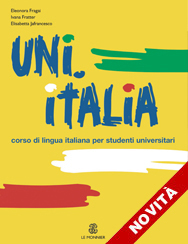By Eleonora Fragai, Ivana Fratter, Elisabetta Jafrancesco
Uni.Italia
Multimedia Italian course for university students
A reflection on the Italian study path for foreigners for students of Italian universitie (120 Kb)
The volume's syllabus (141 Kb)
B1-B2
This project won the 2010 European Language Label
Destined for
foreign students:
enrolled at foreign universities with cultural and scientific collaborative relations with various Italian universities;
studying for their degree at Italian universities;
studying at foreign universities in Italy (US university programmes);
who study materials requiring knowledge of the Italian language abroad (literature, archaeology, history of art, architecture, music);
adult learners:
who for cultural reasons (the traditional public of Italian L2) and professional reasons need an in-depth and specific knowledge of the Italian language;
professionals:
interested in working in Italy in a pluricultural context, who need communicative strategies to be able to work in Italy with particular reference to the working environment.
Objectives
-
to develop linguistic and communicative competence to manage situations in study and professional spheres;
-
to reach a suitable competence to be able to take B2 certificate exams (CELI, CILS, IT), recognised at an international level and permitting enrolment at Italian universities without a further Italian language exam.
Particular attention is dedicated:
-
to the application of specific context of study for the competency descriptors contained in the Common European Framework for Reference for Languages relative to levels B1 and B2, as well as their integration and diffusion.
-
to the development of study skills and strategies for learning mainly in the academic and professional fields, but also applicable in other contexts, through a conscious reflection on the linguistic and communicative mechanisms of the language of study.
The course aims to make the formative route of the recipient to whom it is directed more effective, consistent with the national and European Community indications in the educational sector.
The course asks, for each level, around 60/80 hours of guided didactic activity and of class work, to be integrated with the added hours of work for autonomous study.
Student’s Book Structure
15 Units, both for didactic in-class use and reinforcement activities and for expansion to be done at home. Each unit encompasses a different theme as close as possible to the fields of study and learning interests.
The units are divided in sections, which deal with the linguistic and communicative aspects (textual, lexical, structural), cognitive aspects (study skills, learning strategies) and cultural aspects, making up the course syllabus. The sections of every unit, organised according to a uniform and recursive structure, are as follows:
- Introduction, with activities of pre-contact with the theme;
- Opening theme, with the text that presents the thematic contents and linguistic and communicative objects for reflection;
- Instruments for learning, with activities that aim to develop metacognitive competences connected to knowing to learn;
- Linguistic contents (textual, lexical, grammatical), with texts and activities that propose an elaboration of the linguistic and communicative aspects proposed;
- Expansion, with expansion texts and activities for group discussion;
- Laboratory, with work projects to be developed by turning to multimedia resources of various genres;
- Self-evaluation, with activities to verify the attainment of the unit’s objectives.
As an appendix, systematised Charts of the course’s textual, lexical and grammatical contents.
Teacher’s Guide
-
methodological indications on how to use the Student’s Book as well as suggestions and proposals for supplementary activities;
-
answer key for the Student’s Book’s activities;
-
sources of the texts;
-
bibliographic indications relative to the reference texts used for the volume’s realisation;
-
suggested bibliography.
The DVD with optional support and consolidation activities.
The volume is supplied with a CD containing MP3 audio files. Teachers who wish to receive the audio files in a different format can request them from the publisher.
The Authors
Eleonora Fragai has collaborated for years with the CILS Centre and with CLUSS of the University for Foreigners of Siena. She works on the learning and evaluation of the linguistic and communicative competences of Italian L2 both as a teacher and teacher trainer in Italy and abroad. She is the author of publications on evaluation of the Italian language for children of immigrants and on other didactic aspects of Italian L2, as well as didactic manuals for foreigners.
Ivana Fratter is collaborator and Italian language expert for foreigners at the CLA of the University of Padua. She carries out training activities in the sector of Italian L2 and in this field is author of various publications (hardcopy and multimedia). Since 2001, she holds the chair of the “Education Technologies” and “Class Management” laboratories for the Master of Teaching Italian as a Foreign Language at the University of Padua.
Elisabetta Jafrancesco works at the University of Florence and has collaborated for years with the University for Foreigners of Siena and the University of Padua. She works on Italian didactics for foreigners as both a teacher and teacher trainer. She is the author of publication on various themes regarding learning Italian L2, textuality and pragmatics, e-learning and of didactic manuals for foreigners.
Purchase Options
A Unit
Purchase options
Student’s Book
Volume with CD MP3
pp. 228 ISBN 978-88-00-80074-7
17.00 Euro
Teacher’s Guide (in preparation)
pp. 128 ISBN 978-88-80100-3
DVD (in preparation)
978-8800-80582-7
-
 AFFRESCO ITALIANO
AFFRESCO ITALIANO
Italian course for foreignersCatalogueCourses
-
 Io e l'italiano
Io e l'italiano
Italian course for beginnersCatalogueCourses
-
 Qui Italia
Qui Italia
Italian elementary course for foreignersCatalogueCourses
-
 Nuovo qui Italia più
Nuovo qui Italia più
Italian language course for foreigners (Intermediate Level B2-C1)CatalogueCourses
-
 Sì, lo so
Sì, lo so
Basic Italian courseCatalogueCourses
-
 Un, due, tre
Un, due, tre
Italian language course for foreigners - Children's courseCatalogueCourses





